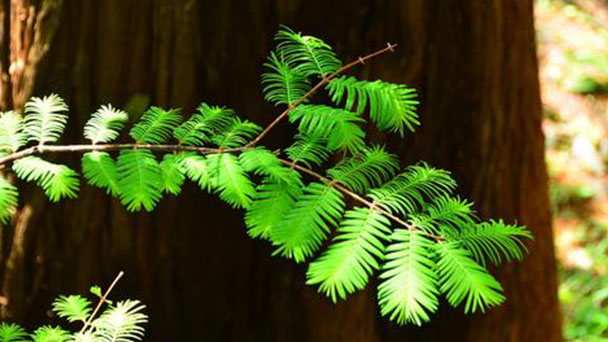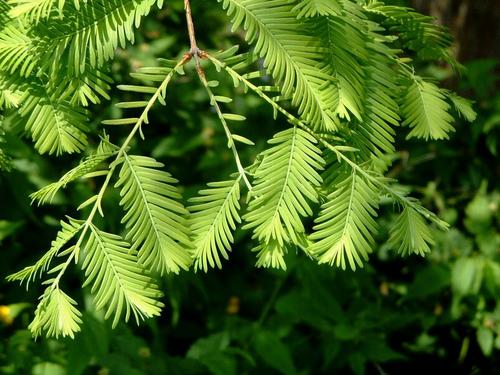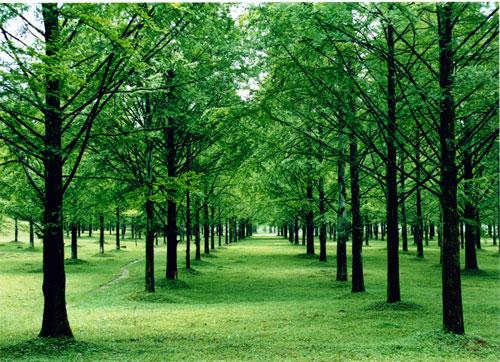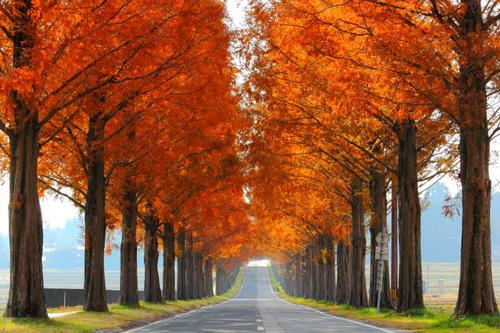Metasequoia Glyptostroboides (Dawn Redwood) Profile
Written by Maggie
Mar 15 2023

Dawn Redwood (Metasequoia glyptostroboides): Gymnospermatic cypressaceae. Dawn Redwood is a deciduous tree, branchlets opposite, pendulous. Leaves are linear, alternating opposite, pseudodiallel into pinnately compound leaves, 1-1.7 cm long, with 4-8 stomatal lines on the lower sides.Hermaphrodite.Cones pendulous, subglobose, micronucleated, 1.8-2.5 cm long, long stalk; Species scales woody, peltate, each with 5 to 9 seeds, the seeds flattened, surrounded by narrow wings.
There were about 6 ~ 7 species of Dawn Redwood in the Cretaceous and Cenozoic of Mesozoic, which was thought to be extinct long ago. The material is light and soft, which can be used for construction, sheet material, paper making, etc. Dawn Redwood is a graceful, ornamental tree for the garden.
Dawn Redwood Picture

Morphological Characteristics of Dawn Redwood
Dawn Redwood is a tree with a height of 35 m and a diameter at breast height of 2.5 m; Trunk base often enlarged; Bark is gray, grayish-brown or dark gray, saplings split into flakes off, trees split into strips off, endothelium light purple-brown; Branches of dawn redwood are oblique exhibition, twigs droop, young tree crown pinnacle shape, old tree crown wide round, branches and leaves sparse; Annual branches are smooth glabrous, green when young, then gradually become light brown, two or three years of branches light brown or brown-gray; Lateral branchlets are pinnate, 4-15 cm long, winter litter; Winter buds on main branches ovoid or elliptic, apically obtuse, ca. 4 mm long and 3 mm in diameter, bud scales broadly ovate, apically rounded or obtuse, nearly equal in length and width, ca. 2-2.5 mm, margin thin and pale, dorsal with longitudinal ridges. Leaves of dawn redwood are striped, 0.8-3.5 (often 1.3-2) cm long, 1-2.5 (often 1.5-2) mm wide, pale green above, paler underside, with two yellowish stomatal bands slightly wider along the midvein, each with 4-8 stomatal lines, leaves in two rows on lateral branchlets, pinnate, falling off with the branch in winter.
Cones of dawn redwood are pendulous, nearly tetragonal globose or rectangular globose, green before maturity, dark brown when ripe, 1.8-2.5 cm long, 1.6-2.5 cm in diameter, peduncles 2-4 cm long, on which there are cross opposite strip leaves; Seed scales woody, estate, usually 11-12 pairs, crossed opposite, scales apically oblate rhomboid, with a transverse groove in the center, base cuneate, 7-9 mm high, breeding scales with 5-9 seeds; Seeds of dawn redwood are flattened, obovate, sometimes orbicular or almost orbicular, surrounded by wings, apically indented, ca. 5 mm long, 4 mm diameter; dawn redwood has 2 cotyledons, striped, 1.1-1.3 cm long, 1.5-2 mm wide, midveins slightly raised on both sides, stomatal lines above, no stomatal lines below; Primary leaves are striate, cross opposite, 1-1.8 cm long, with stomatal lines below.
The Ecological Habits of Dawn Redwood
Dawn redwood likes warm and humid climate, cool in summer, snow in winter but not cold, and the annual average temperature of producing area is 13℃, extreme lowest temperature -8℃, extreme highest temperature 24℃, frost-free period 230 days; The annual precipitation is 1500 mm, and the annual average relative humidity is 82%. The soil is acidic montane yellow soil, purple soil or alluvial soil with a pH value of 4.5~5.5.
In valleys or near the foothills gently topography, soil deep, wet, or a little water, strong cold resistance, resistance to water wet ability strong, saline-alkali land in light optical trees can grow as xi, root development, growth speed is often dominated by soil moisture, in the long-term water drainage of slow growth, stem base) and usually has a longitudinal rib. Dawn redwood is light-loving, poor and drought - tolerant, air - purifying, slow-growing, easy to transplant. The suitable temperature is 8 ~24 degrees below zero.
Dawn Redwood's Distribution Area
A dinosaur-knowing ancient tree that is suitable for planting in contemporary landscapes. Dawn Redwood is a deciduous conifer producing small, round 1/2" to 1" cones. In its youth, it has a neat pyramidal shape, but as it gets older, its crown becomes more rounded. Fall brings an orange-brown or reddish-brown coloration to the feathery, bright green leaves. easy to transplant and quickly growing. prefers moist, deep, well-drained soils and enjoys full sun. one of the trees with the fastest rate of growth. With a spread of 25 feet, it can reach heights of 70 to 100 feet. (zones 5-8) Note: Dawn Redwood grows late in the season and may be damaged by early fall freezes. Plant early enough in the fall to allow the roots to become established and avoid planting in a low-lying area (frost pocket).
Dawn Redwood Propagation
Propagate Dawn Redwood from Seed
After the cones of dawn redwood are mature, the seeds are picked and insolated, and the seeds are screened and dried. The sowing amount of acre is 0.75~1.5kg, the use of drill sowing (row spacing 20~25cm) or broadcast, after sowing grass should not be too thick, often keep the soil moist.
How to Propagate Dawn Redwood by Cutting
Hard and tender cuttings can be used.
- 1. Hard branch cutting
- 2. Cuttings choice of mother tree: cut 1-year-old robust branches from 2~3 years old mother tree for cuttings.
- 3. Cutting and cutting time: in spring.
- 4. Cuttings specifications and treatment: cuttings cut a length of 10~15cm, and then 100 pieces per bundle inserted in the sandy soil to soften, heat preservation, moisture and antifreeze, cutting with a concentration of 100mg/ LabT1 root powder solution soaked for 10~20h.
- After planting management and cutting method: the use of field cuttings, each mu of 20 thousand ~ 30 thousand plants, after planting to take full light seedling, timely watering, weeding, soil loosening.
- 5. Effect: The branches soaked with ABT root powder took root 15~20 days in advance. The roots were thicker and the survival rate was more than 90%, which was about 35% higher than that of other branches without ABT root powder.
Twig cuttings
It takes place in spring. Semi-lignified shoots of dawn redwood were selected as cuttings, 14~18cm in length, with 4~5 leaves at the top and upper parts retained, and inserted into the soil 4~6cm, with 70,000 ~ 80,000 plants per mu. After shading, spray 3~5 times a day. The shade can be removed after autumn. Nursery often keeps moist ventilation, which can promote cuttings early root. Attention should be paid to the prevention and control of blight and stem rot at the seedling stage.

Growing Methods of Dawn Redwood
The planting season can be from late autumn to early spring. Generally, the dawn redwood is better to plant in late winter. Don't plant dawn redwood in the cold season and growing season (summer) when the soil is frozen, otherwise the survival rate is very low. The seedling should be planted along with the rise to avoid excessive water loss. If after a long-distance transportation, after arriving at the destination, should be immersed in water roots. Large seedling transplanting must take soil ball, dig a hole, apply sufficient base fertilizer, fill in fine soil after stepping on solid, after planting to pour permeable water. Extravagant growth period to top dressing, generally chase 1 time, pay attention to soil, weeding.
Weeding Scarification
Weeing and loosening the soil means to remove weeds and vines, loosen the soil to enhance air permeability, improve physical and chemical properties, create comfortable and good soil environment space, improve the root life function, promote its robust and rapid growth, and lay a solid foundation for Dawn Redwood's high yield and high efficiency. Weed the grass and loosened the soil twice a year, and the best effect was obtained in the early stage of Dawn Redwood's vigorous growth.
Moderate Interplanting
In order to make full use of the forest open space, improve the land utilization rate, improve the soil structure, and enhance soil fertility, legume crops or green manure can be interplanted appropriately within 1~2 years of afforestation. In order not to affect the growth of dawn redwood seedlings, interplanting crops should keep a distance of 30~40cm from the tree seedlings. Through the crop in tillage weeding Yao fertilization, already can have the effect that with tillage generation caress, can increase income again, achieve with short raise long goal.
Moderate Pruning
In order to maintain ventilation and light, and create a good space for the robust growth of dawn redwood, moderate pruning should be carried out after the forest is formed. It is advisable to prune from the day after Dawn Redwood leaves to the day before the beginning of spring. The intensity of pruning should be 1/4 to 1/3 of the total length of the crown, depending on the growth of trees.
Disease Control of Dawn Redwood
Coffee Moth
1 to 2 generations occur in a year, with the young moth into the stem harm, causing branches dead, the plant can not grow and bloom normally, or stem cavities and break off.
Prevention and Control Methods:
- Cut off the injured tender branches of dawn redwood, the dead branches are burned;
- Insert the wormhole with iron wire, hook out or stab the larvae to death;
- Pour 80% dichlorvos or 40% diethoate solution 100~200 times into the wormhole, and the wormhole is closed with wet mud to kill the larvae;
- In the incubation period, spray 40% oxidized diethoate, or 80% dichlorvos emulsion 1000~1500 times liquid, or 50% boreline emulsion 1000 times liquid.
Rose Sawfly
Rosa japonicus can occur in two generations every year, overwintering with larvae cocooning in the soil. There is a flocking habit, often dozens of head flocking on the leaves for food, serious when the leaves can be eaten up, leaving only thick veins. Female insect lays eggs in the shoot, can cause the shoot to die.
Prevention and Control Methods:
- Removal of hatching larvae by artificial leaves;
- Control the cocoon in winter to eliminate overwintering larvae;
- Spray 80% dichlorvos emulsion 1000 times liquid, or 90% trichlorfon original solution 800 times liquid, or 50% boreline pine emulsion 1000~1500 times liquid, or 2.5% deltamethrin emulsion 2000~3000 times liquid.
Leafhoppers
It can occur 5 to 6 generations a year, and overwinters as adults in evergreen trees such as Platycladus platycladus or weeds. Nymphs or adult worms use the mouth to prick suction juice, make leaf appears pale white spot, the spot shows patch shape when harm is serious, or prick epidermis, make branch leaf wither.
Prevention and Control Methods:
- Clear the fallen leaves and weeds in the nursery in winter to reduce the source of overwintering insects;
- Use black lamp rust to kill adult insects;
- Spray 2.5% deltamethrin wettable powder 2000 times liquid, or 50% boreline cream 1000 times liquid or 90% trichlorfon 1000 times liquid.
Rust
Symptoms: Fungal disease. Mainly damage leaves and buds of dawn redwood. In spring, the disease begins after leaf expansion. Yellow rust spores are produced on the leaf back, petiole and vein. After breaking through the epidermis, orange rust spores come out and invade the plant. To the early summer, a large number of spread, the formation of orange or yellow-brown powdery summer spore pile, make the leaves lose green-yellow, disease spots obviously raised, serious, the whole plant leaves dead, or dried off the bud.
Pathogenesis characteristics: the pathogen with mycelium or winter spores in the disease bud, disease branch overwintering, spores with the help of wind and rain transmission, invasion by stomata, in the growth season can be repeated infection. Areas with four warm seasons are severely affected, while areas with cold winter and high summer temperatures are less affected.
Method of Prevention and Cure
- Combined with pruning, remove rust branches and leaves of dawn redwood, centrally burned or buried, reduce the source of infection;
- Rational application of nitrogen, phosphorus, potash fertilizer, to prevent growth, pay attention to ventilation and light, do a good job of drainage, reduce temperature, improve plant resistance;
- Spray wave beauty 3~4 sulfur mixture, or 25% powder rust ning 1500~2000 times the liquid, or 65% of the sun zinc wet powder 500~600 times the liquid, or 75% oxidation rust spirit 3000 times the liquid.
The Benefits of Dawn Redwood
Economic
Dawn Redwood sapwood is white, heartwood is brown, the material is light and soft, the texture is straight, the structure is slightly coarse, the hardness difference between morning and evening is big, not resistant to water and wet. dawn redwood can be used for construction, sheet material, paper making, appliance making, model making and interior decoration.
The Botanical Garden
Dawn Redwood is a "living fossil" tree and an ornamental tree with autumn leaves. In the garden most suitable for planting, dawn redwood can also be planted, planting, and can be used for embankment, lakeside, poolside, courtyard and another greening, can also be potted. dawn redwood can also be planted to create landscape forest, and suitable for evergreen ground cover plants; dawn redwood can also be planted in front of buildings or used as a street tree. Dawn Redwood has a certain resistance to sulfur dioxide and is an excellent tree for industrial and mining areas.

Latest Updated
- Metasequoia Glyptostroboides (Dawn Redwood) Profile
- Stromanthe Triostar (Stromanthe Sanguinea) Profile: Facts, Care & Growing Guide
- Can You Divide Peace Lily Plants - When Should You Split
- How to Grow Terminalia Mantaly Tree
- Why My Tea Olive Tree Dropping Leaves?
- How to Prune Peace Lily Plants - 2023 Essential Guide
- How to Growing Peace Lily In Water - Step by Step Guide
- How To Grow Peace Lilies Outdoors - Ways & What to Pay Attention
- Peace Lily Root Rot - Signs & How to Treat
- Why Is My Peace Lily Not Blooming - Causes & How to Get Them Bloom
Popular Articles
- Winter maintenance of Antirrhinum Majus
- How to Grow Terminalia Mantaly Tree
- How to Grow and Care for Crossostephium Chinense
- How to grow Antirrhinum Majus in spring
- Peristeria Elata (Dove Orchid) Profile: Info & Care Guide
- Underwatered Snake Plant (Sansevieria Trifasciata) - Signs And How To Fix
- Rosa Chinensis (China Rose): Plant Growing & Care Tips
- How to Care for Brazilian Jasmine Plant (Mandevilla Sanderi)
- How to Grow & Care for Graptopetalum Purple Delight in Summer
- How to Care for Baby Sun Rose (Aptenia Cordifolia)